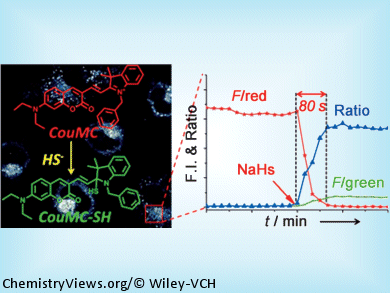Researchers from Nanjing University, China, have synthesized a ratiomeric fluorescent probe that reacts rapidly to H2S and is specific to mitochondria. H2S mediates a range of physiological processes, and there is a correlation between H2S levels and the occurrence of some diseases.
Zijian Guo and his team constructed their probe from coumarin and merocyanine building blocks. The merocyanine unit not only acts as a fluorophore but also a receptor for HS− ions, which are the main form of H2S under physiological conditions. Addition of HS− ions at neutral pH values results in the conversion of the merocyanine to the spiroform and subsequent reduction of its emission intensity, whilst the emission intensity of the coumarin unit is retained.
The probe is selective toward HS− ions, and stands out from other sensing systems as it provides a very quick response (20−30 s). Imaging studies showed that the probe was preferentially distributed in mitochondria, and incubation of cells with NaHS resulted in an enhancement of the merocyanine/coumarin emission ratio. As well as its speed, one further advantage of the probe is that it can be recovered from the nucleophilic addition product at low pH values.
- A Ratiometric Fluorescent Probe for Rapid Detection of Hydrogen Sulfide in Mitochondria,
Yuncong Chen, Chengcheng Zhu, Zhenghao Yang, Junjie Chen, Yafeng He, Yang Jiao, Weijiang He, Lin Qiu, Jiajie Cen, Zijian Guo,
Angew. Chem. Int. Ed. 2013.
DOI: 10.1002/anie.201207701



